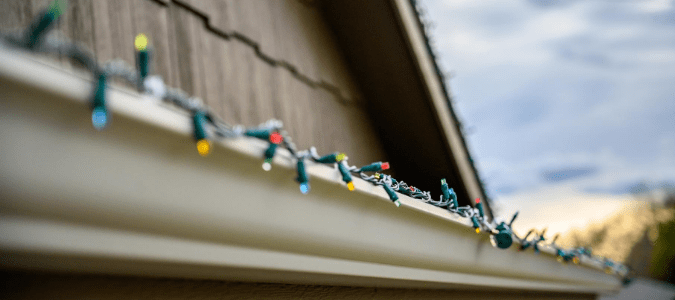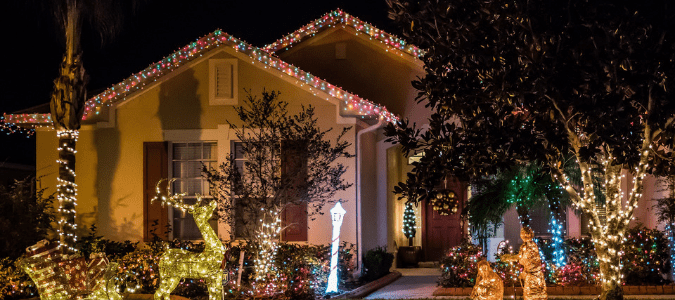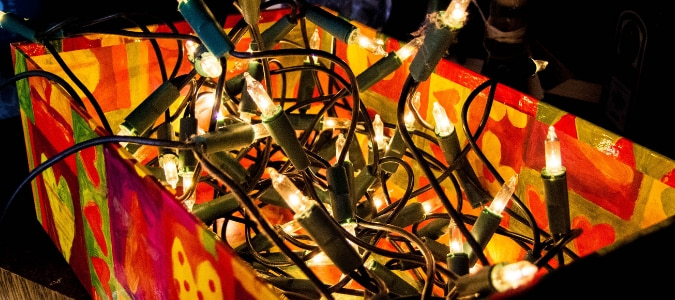
The holiday season brings lots of fun, but it also takes quite a bit of planning. You have to make time for family, friends, holiday parties, shopping and much more. Decorating your property so that it looks beautiful and festive for the season takes some forethought, as hanging Christmas lights incorrectly can cause damage to your home and the lights, and even harm a visitor. A popular and attractive method to hang lights is to string them across the top of your garage. This is why it’s important to learn how to hang Christmas lights from your gutters correctly.
The first step to decorating with Christmas lights the right way is to gather your tools and get prepared before you get started. Every homeowner can decide among different types and brands of lights and fasteners. By getting everything ready before you start, you’re less likely to have to run to the store halfway through the project, wasting valuable time at what can be the most hectic (if not the most joyful) time of year.
Before You Begin
Your first step should always be to design your display. It’s difficult to predict how many lights, clips or extension cords you’ll need without a little advance planning. Take a photo or make a sketch of the parts of your home you intend to decorate so you have a better idea of what you’ll need.
Once you’ve decided on the parts of your eaves you want to decorate, you need to measure how long they are. Houses with mismatched lights simply don’t look as clean as homes where all the lights coordinate. Knowing how much distance your lights need to cover allows you to make sure you have enough strings of lights in advance.
Once you’ve assembled your lights, test them while you’re still on the ground. Over time, strings of Christmas lights can go bad or bulbs can go out. They may simply not light up, or they may develop a short that could cause a fire. Testing them on the ground lets you weed out broken or dangerous lights before you attach them to your gutters. You may need to go to the store to purchase additional sets of lights. Keep in mind that depending on what type you use—mini string lights, LED mini lights, large bulb lights, color changing lights or icicle lights, just to name a few—you’ll be better off using one type in one area so they appear uniform.
Even if the lights work, the next step is to dispose of any strings that have fraying or damaged cords. Why? Because rain and snow can enter the cord through these damaged spots and cause a short. The best-case scenario there is that your lights are fried—the worst is a dangerous fire. It’s better to be safe than sorry.
Attaching Your Lights
Once you’ve decided where your lights are going to go, you can gather your supplies. You’ll need:
- Matching outdoor Christmas lights
- Weather-safe extension cords
- A ladder tall enough to reach the peak of your roof
- Gutter light clips
- Yard stakes
- An assistant
Hanging Christmas lights can be a dangerous and tedious task if you’re not careful. It’s important to be extremely careful to make sure that the lights stay up and you remain on the ladder.
First, start at a corner of your roof, preferably near an exterior outlet. Set your ladder up on even, stable ground and have your assistant hold on. Plug an extension cord into the exterior outlet and then run it horizontally along the ground until it reaches the corner. Use a yard stake to hold the cord in place at the corner, then climb the ladder with the other end in hand.
Once you’re at the top of the ladder, have your assistant hand you the gutter clips and a string of lights. Use one or two gutter clips to secure the extension cord, and then plug in the lights to the cord. From there, use one gutter clip per light bulb to attach the lights to the gutters. This will keep the lights secured and prevent the string from being damaged in bad weather. Using fewer clips will lead to lights that sag and sway and risk the entire strand coming unattached.
Continue this process until you’ve reached the end of the gutter. You may need to plug a second string of lights into the first if your roofline is long. Avoid connecting more than three strings of lights together to keep from overtaxing your outlet. Instead, find another exterior outlet and begin the process from the start with a new extension cord and set of lights.
Stay Safe While Hanging Lights
Follow this advice for a safe light-hanging experience:
- Only decorate in dry, calm weather. Wind, water and ice can all make getting up near your roof incredibly dangerous. Wait until conditions are dry and the wind is low to decorate your roofline.
- When in doubt, move your ladder. It’s better to move your ladder more often than to try leaning to reach a little further. It’s all too easy to lean too far and tip your ladder over. Instead, move your ladder every five to ten feet of roofline so you can easily reach.
- Always have an assistant. Your assistant will help keep the ladder stable, hand you things so you don’t have to climb up and down and tell you if the decorations look right. With another set of hands (and eyes), you’ll stay safe while working up high.
- Follow safety instructions on your lights. Different brands of lights have different wattages. Depending on your lights, you may only be able to connect two strands together, or you may be able to string three or four on the same circuit. Read the instructions and when in doubt go with fewer strings on a single circuit.
Starting to sound like too much work? You’re not alone. Many homeowners reach out to local holiday lighting specialists to decorate your home instead. That way, you can spend more time with your family instead of working on your lights on your own. Professionals have the experience necessary to help you figure out your lighting needs and get your home done up in no time, so you can spend more time with friends and family and working on your holiday playlist.
If you go the do-it-yourself route, you’ll also need to figure out how many Christmas lights you’ll need for your property and what kind of lights to purchase. Keep reading to learn more about these topics and more.

How Many Christmas Lights Do I Need for My House?
For flat surfaces, this number is relatively easy to come up with. Any flat surface you want to decorate—windows, door frames and other architectural details—can be measured as flat lines. For example, to calculate the number of lights needed to decorate your eaves, measure the length of the gutters to see how much distance your strings of lights needs to cover. This gets a little more difficult if you’re working with a peaked roof, but the basic rule is still the same. Make sure to add five feet to your number to account for slack and for the neutral plug end of the cord.
Pillars and other round objects are a little tricky. If you intend to wrap the lights around the pillar, your best bet is to measure the distance with a flexible measuring tape. Wrap the tape around the pillar the way you would like your lights to hang. The result of the tape will be the exact length your lights need to be.
Trees and bushes are more complicated. Instead of length, you need to consider the number of lights themselves. Ideally, bushes and trees benefit from about 100 lights for every 18 inches of height. Following that logic, a seven and a half foot tree would look best with about 500 lights. Instead of length, you’ll be looking for the light count on your strings, which can typically be found in one of the bottom corners of the packaging. Just remember to get extension cords to power all of these areas. Net lights are a popular addition to adorn bushes that generally come in the shape of a large rectangle that you can then drape over your shrubbery.
If you’re worried about making a math mistake or having to make multiple trips to a crowded hardware store, you may choose to hire a professional. Lighting experts can quickly take care of this for you so you’ll have your Christmas lights hung for you without having to deal with the hassle of doing this yourself.

LED Christmas Lights vs. Incandescent: Which is Best?
When you’re ready to recycle your any non working or outdated Christmas lights and buy some new ones, you have two main lighting options: LED and incandescent. These two lighting methods continue to compete in the aisles of hardware stores yearly, but LED lights are slowly but surely winning out. There’s a reason for that.
LED lights are energy-efficient in a way incandescent bulbs just aren’t. The cost of running an LED light can be as much as 90% less for the same amount of brightness as an incandescent bulb. If you’re really decking the halls, that kind of energy savings will keep your electricity bills much lower this year. LEDs also last much longer. Even the small lights on a string of Christmas lights can last as long as 25,000 to 75,000 hours. Comparatively, incandescent bulbs last around a thousand hours.
There are a couple of reasons that incandescent bulbs have hung around for Christmas, though. First, incandescent bulbs generate heat in a way that LEDs don’t. That can help keep incandescent lights visible despite snow. Households in warmer areas of the U.S. don’t have to worry about this quite as much, but there’s a second factor keeping incandescent lights around: they’re much cheaper than LEDs.
Overall, it’s generally agreed that LEDs are a better choice. They save you money in the long run, they last longer and they don’t put your house at risk for fire. The result is a gorgeous home without a high electricity bill and lights you can use year after year.
ABC Can Make Your Home Merry and Bright
Although the holidays are a wonderful time, it can also be stressful. Let ABC Home & Commercial Services take one thing off of your to-do list by enlisting our help for your holiday lighting needs. We can come with everything needed to get your home in the holiday spirit, so you can spend more time perfecting holiday recipes and making special memories. With ABC’s help, you can have a season that’s both merry and bright.
